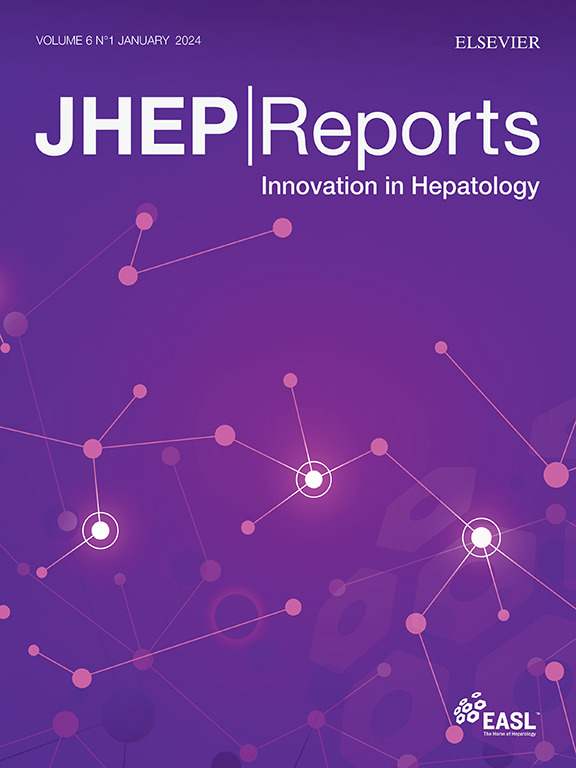用于减少治疗试验中筛选失败的纤维化MASH的非侵入性试验
IF 9.5
1区 医学
Q1 GASTROENTEROLOGY & HEPATOLOGY
引用次数: 0
摘要
背景,代谢功能障碍相关脂肪性肝炎(MASH)的治疗试验受到70-80%筛查失败率的阻碍,这主要是因为基线肝活检中没有纤维化MASH,这强调了更好地选择候选人的必要性。我们比较了八种非侵入性检查的性能,设计或不用于诊断纤维化MASH。方法在5个三级医疗中心共纳入1005例经组织学证实的MASLD患者。对纤维化NASH的三种非侵入性检查进行评估:简单血液检查纤维化NASH指数(FNI)、专门血液检查MACK-3和基于弹性成像的检查FAST。我们还评估了推荐用于晚期纤维化的五种非侵入性检查:简单血液检查FIB-4、专门血液检查FibroTest和增强肝纤维化试验(ELF™),以及基于弹性成像的检查FibroScan和Agile3+。纤维化型MASH定义为MASLD活性评分≥4,纤维化评分F≥2的MASH。结果在单纯血液检查(n = 1005)中,FNI对纤维化MASH的受试者工作特征下面积(AUROC)明显高于FIB-4(0.709[0.677-0.741]比0.662 [0.628-0.695],p = 0.019)。在基于弹性成像的试验(n = 817)中,FAST的AUROC(0.774[0.743-0.806])显著高于FibroScan (0.728 [0.694-0.763], p = 0.013)和Agile3+ (0.708 [0.672-0.744], p = 0.004)。在专门血液检查(n = 545)中,MACK-3的AUROC(0.772[0.734-0.811])明显高于FibroTest (0.615 [0.568-0.663], p <0.001)和ELF (0.700 [0.656-0.744], p = 0.028)。顺序组合(FAST然后Agile3+;MACK-3(然后是ELF)确定了一个子集,其中包括三分之一的患者,其中假阳性率仅为30%。结论:采用为纤维化MASH设计的一线试验的顺序组合提高了MASH治疗试验候选患者的识别。影响和意义代谢功能障碍相关脂肪性肝炎(MASH)的药物开发受到高筛查失败率的阻碍,主要原因之一是基线肝活检中没有MASH和明显纤维化(纤维化MASH),这是MASH治疗试验的关键纳入标准。非侵入性测试为更好地选择这些试验的候选人提供了一个有吸引力的机会,但它们中的大多数是为晚期纤维化开发的,而用于诊断纤维化性MASH的新测试仍然缺乏验证。在这项工作中,我们证明了专门为纤维化MASH设计的测试比目前推荐的和最初为晚期纤维化开发的测试更准确。我们提出了顺序组合,这将有助于识别需要治疗的纤维化MASH患者,并将其纳入MASH治疗试验。本文章由计算机程序翻译,如有差异,请以英文原文为准。

Non-invasive tests for fibrotic MASH for reducing screen failure in therapeutic trials
Background & Aims
Therapeutic trials in metabolic dysfunction-associated steatohepatitis (MASH) are hampered by a high 70–80% screen failure rate mostly because of the absence of fibrotic MASH on baseline liver biopsies, underscoring the need for better selection of candidates. We compared the performance of eight non-invasive tests, designed or not for the diagnosis of fibrotic MASH.
Methods
A total of 1,005 patients with histologically proven MASLD were included in five tertiary care centers. Three non-invasive tests developed for fibrotic MASH were evaluated: the simple blood test Fibrotic NASH Index (FNI), the specialized blood test MACK-3, and the elastography-based test FAST. Five non-invasive tests recommended for advanced fibrosis were evaluated as well: the simple blood test FIB-4, the specialized blood tests FibroTest and Enhanced Liver Fibrosis test (ELF™), and the elastography-based tests FibroScan and Agile3+. Fibrotic MASH was defined as MASH with MASLD activity score ≥4 and fibrosis score F ≥2.
Results
Among simple blood tests (n = 1,005), FNI had a significantly higher area under the receiver operating characteristic (AUROC) for fibrotic MASH than FIB-4 (0.709 [0.677–0.741] vs. 0.662 [0.628–0.695], p = 0.019). Among elastography-based tests (n = 817), FAST had a significantly higher AUROC (0.774 [0.743–0.806]) than FibroScan (0.728 [0.694–0.763], p = 0.013) and Agile3+ (0.708 [0.672–0.744], p = 0.004). Among specialized blood tests (n = 545), MACK-3 had a significantly higher AUROC (0.772 [0.734–0.811]) than FibroTest (0.615 [0.568–0.663], p <0.001) and ELF (0.700 [0.656–0.744], p = 0.028). Sequential combination (FAST then Agile3+; MACK-3 then ELF) identified a subset including one-third of patients in whom the false-positive rate was only 30%.
Conclusions
Sequential combinations using first-line tests designed for fibrotic MASH improves the identification of candidates for MASH therapeutic trials.
Impact and implications
Drug development in metabolic dysfunction-associated steatohepatitis (MASH) is hampered by a high screen failure rate, one of the main reasons being the absence of MASH and significant fibrosis (fibrotic MASH) on the baseline liver biopsy, a key inclusion criterion in MASH therapeutic trials. Non-invasive tests represent an attractive opportunity to better select candidates for these trials, but most of them have been developed for advanced fibrosis and the new tests designed for the diagnosis of fibrotic MASH remain poorly validated. In this work, we demonstrate that the tests specifically designed for fibrotic MASH are more accurate for this diagnostic target than the tests currently recommended and initially developed for advanced fibrosis. We propose sequential combinations that will facilitate the identification of patients with fibrotic MASH in need of treatment, and their inclusion in MASH therapeutic trials.
求助全文
通过发布文献求助,成功后即可免费获取论文全文。
去求助
来源期刊

JHEP Reports
GASTROENTEROLOGY & HEPATOLOGY-
CiteScore
12.40
自引率
2.40%
发文量
161
审稿时长
36 days
期刊介绍:
JHEP Reports is an open access journal that is affiliated with the European Association for the Study of the Liver (EASL). It serves as a companion journal to the highly respected Journal of Hepatology.
The primary objective of JHEP Reports is to publish original papers and reviews that contribute to the advancement of knowledge in the field of liver diseases. The journal covers a wide range of topics, including basic, translational, and clinical research. It also focuses on global issues in hepatology, with particular emphasis on areas such as clinical trials, novel diagnostics, precision medicine and therapeutics, cancer research, cellular and molecular studies, artificial intelligence, microbiome research, epidemiology, and cutting-edge technologies.
In summary, JHEP Reports is dedicated to promoting scientific discoveries and innovations in liver diseases through the publication of high-quality research papers and reviews covering various aspects of hepatology.
 求助内容:
求助内容: 应助结果提醒方式:
应助结果提醒方式:


